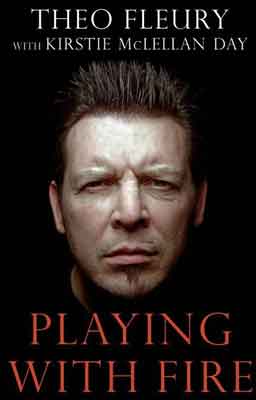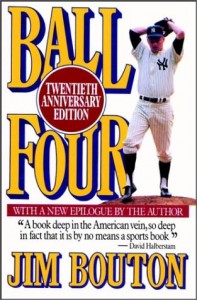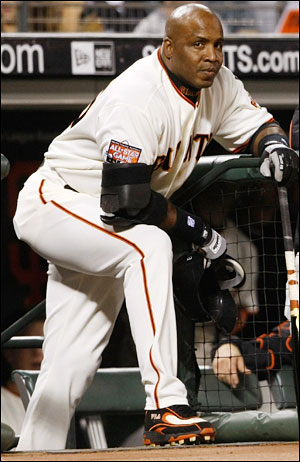Book review – The Way of Baseball
As I've alluded to once or twice, I used to work for the World's Biggest Bookstore in downtown Toronto, a part of the Chapters-Indigo chain.
About the same time I moved on to being a professional writer many of my coworkers at the WBB also moved on to bigger and better things, including my manager Justin Sorbara-Hosker, who now works for Indigo's online department.
A couple of weeks ago Justin and the staff at Simon and Schuster were kind enough to forward me a copy of Shawn Green's new book "The Way of Baseball" which I reviewed for Indigo's blog.
Below is my introduction, followed by a link to the rest of the article.
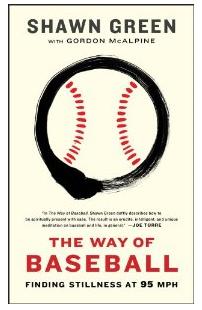 Shawn Green's The Way of Baseball has a concept so simple it's amazing no one has done it before—it uses hitting a baseball as an evolving metaphor that can be applied to everyday life.
Shawn Green's The Way of Baseball has a concept so simple it's amazing no one has done it before—it uses hitting a baseball as an evolving metaphor that can be applied to everyday life.
Green draws on his career as a right-fielder with the Toronto Blue Jays, Los Angeles Dodgers, Arizona Diamondbacks and New York Mets and examines how he used batting practice as a method of finding peace and balance in his day-to-day life.
The book is broken into nine chapters titled “Stillness,” “Space and Separation,” “Awareness,” “Ego,” “Presence,” “The Zone,” “Nonattachment,” “Gratitude,” and “Epilogue”. Each section details a step in Green’s personal journey as he develops stillness and awareness at the plate and in his interactions with teammates, coaches and fans.
Book Review – The Book of Basketball
 The Book of Basketball seemed like the perfect book for me, a natural fit.
The Book of Basketball seemed like the perfect book for me, a natural fit.
But Bill Simmons’ magnum opus, although entertaining and somewhat informative, fell short of my expectations.
You see, like most Canadians, I don’t know a lot about basketball. Sure, I watch maybe a game per week, I know the big name players and I certainly respect their athleticism and the skill necessary to play in the National Basketball Association.
But that level of interest pales in comparison to my obsession with hockey. That’s just the sad truth: In Canada, basketball always plays second fiddle to hockey. From an early age we’re all ingrained with an understanding of hockey that fuels our fascination.
It’s hard for any sport, especially one that runs at roughly the same time as the National Hockey League, to gain any kind of popular traction amongst Canadians.
What it boils down to for me is this: if you gave me a TV with only two channels, one broadcasting the classic 1986 NBA Finals with Magic Johnson’s Los Angeles Lakers facing Larry Bird’s Boston Celtics and the other showing a pre-2004 lockout game between the New Jersey Devils and Minnesota Wild, I’d probably end up watching the hockey.
However, I’m always trying to broaden my horizons, especially when it comes to sports and writing, and so I want to expand my basketball knowledge base.
Further, Simmons has always impressed me as an imaginative writer who can inform and amuse. Anyone who’s read his blog or followed him on Twitter knows he has a deep and abiding passion for basketball, so it seemed like reading his tome would be the perfect way to familiarize myself with the game.
There’s no denying that I learned a lot from Simmons’ 736 page treatise on every imaginable detail of professional basketball. His meticulously researched book does a lot to explain the evolving styles of play as well as the different personalities that have made up the NBA and American Basketball Association.
His lengthy footnotes and parenthetical asides made me laugh out loud and his pop-culture references are always on point. He’s got a gift for keeping sections that would otherwise be deathly boring fun and fresh. Unfortunately, they also add about an extra 100 pages to an already lengthy book.
That’s just one symptom of this book’s fatal flaw: it is poorly edited. Simmons should’ve been reined in to try and keep the book and more manageable length.
Further, a more consistent naming protocol should have been used. Player’s first names, last names and nicknames are used interchangeably from paragraph to paragraph, sometimes sentence to sentence. Although it can lead to some echoes in the writing, sticking to a standard would have lowered the word count - and in a book this big that could end up cutting some pages – and would have made the book more accessible.
This is where the book ultimately failed me.
As a survey of the history and players of professional basketball, the Book of Basketball seemed like the ideal entryway for a novice fan trying to learn about the sport. But it seems as though Simmons never really decided who his target audience was going to be, and so his narrative swings from being explanatory and appropriate for the new fan, to detailed and filled with in jokes only a long-time NBA fan would get.
Writing a book for the sophisticated fan is fine, but it should be advertised as such and be consistent in its level of accessibility. Unfortunately, the Book of Basketball is all over the map in comprehension, making it a frustrating read.
Bill Simmons’ Book of Basketball is funny and smart, but could’ve used a more firm editorial hand to rein in some of the author’s lengthier footnotes and asides to make a slightly more concise book that is accessible for all readers.
My Top 10 Essential Sports Books
My friend Justin asked me to write a blog post of my top 10 essential sports books, and, well, who am I to deny my faithful readers?
Justin didn’t give me much of an outline beyond the fact that they should be non-fiction and that they’re books that would be essential for starting anyone looking to start a personal sports library.
I decided to interpret “essential” as a book that is timeless, has a broad scope that makes it accessible and, of course, features strong writing.
Variety was also a watchword when I put this together. When it comes to writing not all sports are created equal – coming up with a list of 10 baseball books is a snap, while naming even five essential hockey books can be tricky.
However, I did manage to get a decent spread of sports. Baseball, hockey, soccer, football, professional wrestling and other combat sports are all well represented.
I should also add that this list is designed to be taken as a whole. Many of these books are meant to dovetail with each other, provide contrast or compliment other entries.
They don’t need to be read in any particular order and none of them stand out as the best of the lot. But taken altogether all ten fit together nicely, giving the reader a reasonably broad understanding of sports and athletics, even if some specific sports are left out.
Of course, I’ll also point out that I’ve read all of these books (titles that have a link will take you to my earlier, full reviews of the book). Since I haven’t read every sports book ever there are, I’m sure, some gaps in my selections.
Now, in no particular order of preference:
The grand daddy of ‘em all, Ball Four is Jim Bouton’s memoir of a year as a major league pitcher with the Seattle Pilots and later the Houston Astros. This book is the first real, hard-hitting look at the world of baseball – or any sport for that matter. Incendiary when it was released in 1969, Bouton’s book remains funny and insightful. Context will help you enjoy it, but 75% of the book can stand on its own. Admitedly, some of its power has been lost to time, but definitely worth reading, particularly the sections on some of Bouton’s more famous colleagues like Mickey Mantle and Ted Williams.
Bullpen Gospels by Dirk Hayhurst
Another relief pitcher’s memoirs, Bullpen Gospels comes from a more sincere and self-deprecating perspective. Dirk Hayhurst’s book on his year in the San Diego Padres’ minor league system is less about baseball and more about finding himself and trying to make some sense of the mess that is his life. Bullpen Gospels’ introspective narrative gives the reader a glimpse inside the surprisingly fragile psyche of a professional athlete and stands in contrast with Bouton’s groundbreaking work. It’s amazing to see how things have changed in the 50 years between the two memoirs. That said, some things never change – like baseball players womanizing ways.
Living on the Black by John Feinstein
My third pick also features professional baseball pitchers, but manages to be completely different from the earlier entries. John Feinstein’s tome (it’s a hefty 508 pages) follows the 2007 seasons of soft-tossers Tom Glavine and Mike Mussina. Living on the Black discusses the history of the players association and explains the ongoing evolution of the pitcher. Reading this book gave me a much stronger understanding of the importance of every pitch and every at bat of baseball. This book comes as close to explaining the art of big league pitching as anyone can without actually suiting up.
Searching for Bobby Orr by Stephen Brunt
Stephen Brunt’s biography of Bobby Orr – certainly the best defenceman of all time, and arguably the best hockey player ever – is marked by the fact that it was totally unauthorized. The seasoned Globe and Mail columnist had to dig deep for years to find anyone willing to speak to him about the very private Orr. All that hard work paid off as Brunt paints a rich portrait of a complicated man who revolutionized the sport of hockey on and off the ice. Searching for Bobby Orr is worth reading if just to be immersed in Brunt’s breathless description of Orr’s trademark end-to-end rushes. A must read for understanding the modern National Hockey League.
Hitman by Bret Hart
Although professional wrestling isn’t really a sport, there’s no denying the athleticism of the performers. Bret Hart’s upbringing as the most prominent member of the Hart family of wrestlers puts him in a unique position to describe the crazy lifestyle of the World Wrestling Federation. At the same time, Hart’s incredibly violent home life, coupled with his constant marital infidelity is engrossing and makes this the grittiest of all the entries on this list. This autobiography is, in a word, jarring. There is no book that is so open and honest about the sex and violence that pervades the lives of professional athletes.
 A Fighter’s Heart by Sam Sheridan
A Fighter’s Heart by Sam Sheridan
The only sport that comes close to baseball’s massive catalogue of books is boxing. Unfortunately, the sweet science is only one corner of the world of combat sport. Therefore, I chose Sam Sheridan’s survey of all sports where athletes fight – from boxing to Brazilian Jiu Jitsiu to mixed martial arts and, yes, even cock fighting – to try and encompass one of the more literary sports. Sheridan tries valiantly to understand the role that organized combat has in society and what it is about prizefighting that attracts competitors and spectators alike. An intersting and thought-provoking read that provides insight into the fringes of professional sport.
How Soccer Explains the World by Franklin Foer
Like A Fighter’s Heart, Franklin Foer’s How Soccer Explains the World tries to figure out the role of sport in a greater socio-political context. Foer’s theories are a little over-simplistic and he’s not without his biases, but nonetheless it’s an excellent book that successfully draws connections between political movements, sectarianism and nationhood with soccer teams around the world. An excellent sports book for the non-fan, and enjoyable and informative for anyone who believes that sport is an integral part of society.
Friday Night Lights by Buzz Bissinger
You’ve probably seen the movie or the TV show, but as good as they are, they just don’t do justice to Buzz Bissinger’s original examination of high school football in the oil town of Odessa, Texas. Although he doesn’t draw conclusions like Sheridan or Foer, Bissinger goes into greater depth than the other two books. Dark, sure, but Friday Night Lights does an incredible job of showing, at least on a small scale, how important sports can be to a community. By the final chapter you might not feel like a Permian Panther, but you’ll definitely sympathize with these young men.
Moneyball by Michael Lewis
Possibly the most influential book on this list, Michael Lewis’ Moneyball is often misunderstood as being a kind of baseball strategy guide. Really, it’s all about Oakland Athletics’ general manager Billy Beane squeezing the potential out of undervalued properties – in this case, baseball players. It’s a philosophy that goes well beyond the world of baseball, and the book’s become popular in many business circles. There’s lots to learn from Lewis’ most popular book: the intricacies of baseball trades, the importance of walks and the rigidity of old school baseball. Stay ahead of the curve by picking it up before Brad Pitts’ film adaptation comes out.
Fever Pitch by Nick Hornby
Speaking of books being ruined by movie adaptations – please ignore the romantic comedy starring Jimmy Fallon and Drew Barrymore loosely based off of Nick Hornby’s Fever Pitch. It’s barely related to the original. Few books capture the agony of cheering for a team that just never gets it together. You can sustitute any number of clubs for Hornby’s Arsenal. The Chicago Cubs, Detroit Lions and Toronto Maples Leafs will all do fine. This is what fandom is all about: not the highs of winning a championship but the agonizing lows where every bounce goes for the other side, where every home game gets rained on and every draft pick is a bust. Hornby captures that pain perfectly.
Book Review – The Glass Castle by Jeannette Walls
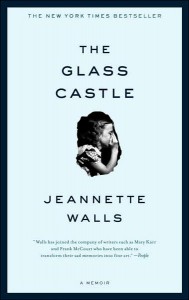 I never thought that I’d enjoy Jeannette Walls’ the Glass Castle, but I was wrong.
I never thought that I’d enjoy Jeannette Walls’ the Glass Castle, but I was wrong.
On the surface, it looked like it was more for stay-at-home moms. It was one of Heather’s Picks at Chapters-Indigo Bookstores and reeked of Oprah’s Book Club. But once I started reading it I appreciated Walls’ writing and was moved by her story.
Like Frank McCourt’s ultra-popular Angela’s Ashes, the Glass Castle is a dark memoir about a dysfunctional family crippled by the father’s alcoholism and the mother’s loose grip on reality.
The Glass Castle also follows a very similar format to Angela’s Ashes with each short chapter detailing an episode from the childhood of the author. More often than not these are horrible snapshots of poverty or struggle as the Walls’ household disintegrates.
These grim anecdotes are broken up by some funny stories from Jeannette’s childhood and the reader is buoyed up by the loyalty of her three siblings as they try to support each other and overcome their parents’ shoddy upbringing.
Walls’ writing is very good and although the subject matter is depressing and unsettling, she wisely injects some humour to create some balance.
What interested me the most was the social dynamics within the Walls household. Jeannette and her three siblings all independently come to the conclusion that their parents are unfit to raise them and that they need to take matters into their own hands.
Writing a compelling memoir is difficult. I’ve read many autobiographies that tell the author’s life story chronologically and from a single perspective. That’s a totally fair and natural way to structure a narrative, especially since an omniscient narrator would be some trick, but it’s obviously also quite limiting.
But Walls – a long-time journalist and former blogger with MSNBC.com – does well to flesh out the “characters” of her family and imply the feelings and motivations of each relative. This adds depth to her story that most autobiographies lack. The way her parents and sibling handles each situation is unquestionably real.
Walls is also a reasonably fair and balanced narrator. Her family might not be thrilled with their personal histories being exposed, but it’d be hard for any member of the Walls clan to say that Jeannette did them a disservice. She lets their actions speak for themselves and rarely puts words in their mouths.
Normally I would dismiss the Glass Castle out of hand. But Walls’ incredible storytelling abilities and the devastating circumstances of her childhood make this memoir a must-read for any fan of literature.
Graphic Novel Review: The Rocketeer: Complete Adventures by Dave Stevens
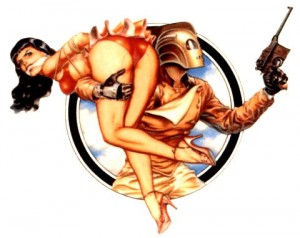 Sometimes it’s hard to articulate your feelings about a book or movie. Other times it just comes to you, like when I recently finished reading The Rocketeer: the Complete Adventures, a reprinting of Dave Stevens’ seminal series that was originally published n 1982.
Sometimes it’s hard to articulate your feelings about a book or movie. Other times it just comes to you, like when I recently finished reading The Rocketeer: the Complete Adventures, a reprinting of Dave Stevens’ seminal series that was originally published n 1982.
I found myself saying: “Really? That’s it?”
Not that it was a knock on the content of the book. The artwork is gorgeous and really pops thanks to the re-colouring done for this edition by Laura Martin. Stevens’ stories are good too, with some decent action as stunt pilot Cliff Secord learns to use a stolen jetpack and win back his best girl, Betty.
Stevens does an excellent job of building a sense of suspense, particularly in the second story “Cliff’s New York Adventure”. It’s a nice touch that he incorporated his hero into the Wold Newton Universe, having him work alongside the Shadow and with associates of Doc Savage.
But that’s the final story. There’s only two.
This was not what I was expecting, at all. As I made my way through the book I was waiting a third and final act that would match up with the ending of the 1991 film adaptation starring Billy Campbell and Jennifer Connelly. That climax never comes.
Instead, the Complete Adventures end with Secord leaving New York City for Los Angeles, with the expectation that he’ll be reunited with his girlfriend Betty. There should be another third to this book, but it just ends on that note. It’s an anti-climactic end to an otherwise enjoyable book.
I guess that’s the rub: those first two stories really are great. They’re fun and pulpy and in many ways are like Alan Moore’s Tom Strong.
But with any of the Tom Strong books there’s a sense that these are just a few of hundreds if not thousands of stories, and theyère much more detailed and fulfilling. The Rocketeer leaves you hanging.
It’s a shame that there wasn’t more to the series, and even worse, there never will be since Stevens passed away in 2008.
All in all, The Rocketeer: the Complete Adventures is a fun read and it has gorgeous artwork, but it’s disappointing that it’s so short and, ultimately, feels incomplete. It's a great concept, I just wish there was more of it.
If you’d like to read a second opinion, I’d recommend Chris Sims’ review of the Complete Adventures from December 2009.
Book Review: the Imperfectionists by Tom Rachman
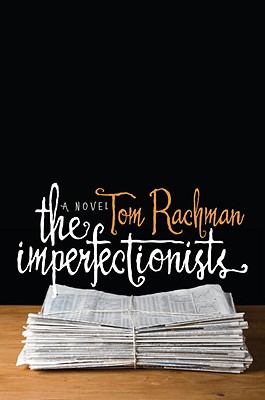 As much as I love reading, it’s rare that a book leaves me breathless. Tom Rachman’s the Imperfectionists does just that, over and over again.
As much as I love reading, it’s rare that a book leaves me breathless. Tom Rachman’s the Imperfectionists does just that, over and over again.
Rachman is a London-born journalist who has worked all over the world and he chose a familiar subject for his debut novel – the newsroom of an English-language paper in Rome.
Each chapter revolves around a different staff member or reader, with many of their stories intersecting and building on previous episodes. At every interval there is a short story about the history of the paper, colouring in some of the background of the main storyline.
It’s a masterful plot structure, deftly done, especially for a first-time novelist. The way the disparate characters and storylines intertwine and relate shows how skilled Rachman is as a storyteller.
The book had been recommended to me by my fiancé, who knew it’s tales of deadline drama in a newsroom would appeal to me, and she was spot on. Although Rachman never stoops as low as cliché or caricature, many of the characters rang true.
All of the characters are sketched out with a deft touch rarely seen in even the best authors, let alone by a first-timer. Rachman’s cast are remarkably realistic and likeable, creating sympathy for the characters and disappointment when things inevitably turn sour for the protagonists.
That’s really my one complaint about the Imperfectionists – it’s unrelentingly depressing. No good deed goes unpunished in Rachman’s world. Characters are craven and selfish. Infidelity is common with everyone ending up alone. Even success comes at a great cost in this world.
Half-way through I was dying for at least one good thing to happen to a character. Some sort of ray of hope, one chance at redemption. Anything! I was desperate for a lifeline, but it never came.
No, Rachman never gives up on his dark outlook, with the final chapter being one of the most heartbreaking.
Despite that, the Imperfectionists is an excellent read that will impress you with its complex structure. Although I was introduced to it because of my occupation as a journalist, I think this book would appeal to anyone. Definitely worth checking out.
Graphic Novel Review: Tom Strong by Alan Moore and Chris Sprouse
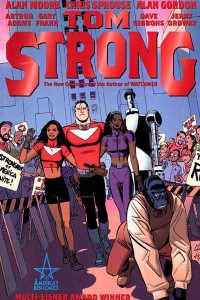 Every medium has its strange little quirks. Odd little rules of the form that have developed and that creators rarely deviate from.
Every medium has its strange little quirks. Odd little rules of the form that have developed and that creators rarely deviate from.
For example, it is rare for a movie to have a plot that unfolds in real time. Television shows are limited in length by half-hour increments, allowing, of course, for commercials. You may see a program that’s 15 minutes long, but never 45 minutes.
It’s theoretically possible to have a show be 20 minutes long or a movie that is in real time, but it’s rarely if ever done in practice.
Comic books are no different. They have their own rules and standards that creators are obliged to follow.
One of the most peculiar things about sequential art as a medium is that it is largely devoted to a single genre – superhero action/adventure.
There are certainly lots of comics that do not involve capes or tights. But the vast majority of the comics produced in this medium prominently feature superheroes.
It wasn’t always this way. In the aftermath of the Second World War, superhero titles began to disappear off the rack. Only Batman, Superman and Wonder Woman survived in any form. Titles like Captain America, Captain Marvel and Green Lantern were replaced by Westerns, Romances and especially horror books.
However, as the Silver Age dawned with Showcase #4 and Fantastic Four #1, superheroes came back in to vogue. DC and Marvel plunged into producing cape and tights stories almost whole hog. Even characters that were of other genres like Nick Fury, Jonah Hex, Mille the Model, Patsy Walker and the Two-Gun Kid were folded into their mainstream continuity.
Since then, the medium and the genre have been inexorably linked. Sure, there are still some comics that do not feature superheroes, but they are few and far between.
It would be like if CBS and NBC’s programming was almost entirely police procedural dramas.
All this serves a lengthy preamble to talk about Alan Moore’s America’s Best Comics, an attempt by the famed author to break free from the superhero genre. He introduced books like Top 10, Promethea and Greyshirt that were departures from the usual comic book fare.
The most prominent work in the ABC line was Tom Strong, an analog of Doc Savage, Tarzan, Tom Swift and other pulp-styled heroes of the early 20th century.
Although still definitely an action-adventure story, Tom Strong is not a crime fighter or vigilante of any sort. His primary interest is science and education. He’s constantly inventing Swiftian devices that, predictably, become useful in his latest adventure. He is a utopianist devoted to improving his world.
Of course, Strong is often beset by villains who want to destroy his hometown of Millennium City or kill him to avenge an earlier defeat. Enemies like Nazi air pirate Ingrid Weiss, technological plague the Modular Man and Strong’s arch-nemesis Paul Saveen plague the hero and his family.
They’re all fun, off-beat characters that can make you laugh while remaining threatening to the safety of Tom Strong and his extended family.
As always, Moore does a fantastic job of developing characters quickly and creating entertaining traps for Strong to unravel, all while maintaining the traditional sense of fun inherent in all pulp fiction.

Chris Sprouse's incredible work on Tom Strong. Tom Strong is conceived as Pneuman the Pneumatic Man watches on.
Chris Sprouse’s artwork shines. It’s crisp, clean and expressive, while being remarkably detailed where required. He’s a master illustrator who can communicate emotions to his readers in a single, textless panel. It’s some of the best artwork I’ve ever seen in a comic.
Sprouse isn’t the only penciler on this series though. Other acclaimed artists like Arthur Adams, Gary Frank, Dave Gibbons and Jerry Ordway lend a hand. Their inclusion in the project was done in a very clever way – they draw all the flashback scenes. Because these looks into Tom Strong’s past are presented as older issues of the series, the different styles aren’t jarring and, if anything, add to the whole piece.
I would recommend Alan Moore’s Tom Strong to anyone who enjoys comics, but especially to those who want a break from the more mainstream and mundane superhero books that clutter shelves at your local shop. He remains one of the few creators in the medium that can shed the cloak of superheroes.
Book Review: King Leary by Paul Quarrington
 Paul Quarrington’s novel King Leary is a funny, insightful look at the world of professional hockey in the early 20th century that would be enjoyable for fans of the sport or someone looking for a quick read.
Paul Quarrington’s novel King Leary is a funny, insightful look at the world of professional hockey in the early 20th century that would be enjoyable for fans of the sport or someone looking for a quick read.
Published in 1987, Quarrington’s tale won the Stephen Leacock Medal for Humour in 1988 and was shortlisted for that year’s Trillium Book Award.
It regained prominence in 2008 when the Rheostatics' Dave Bidini championed it for the CBC’s Canada Reads program. Bidini’s campaign saw King Leary become a best-seller and win the award 10 years after it first appeared on book shelves.
Narrated by Percival “King” Leary, one of the greatest professional hockey players to ever live, the story follows him as he travels from his retirement home to Toronto to shoot a ginger ale commercial with Duane Killebrew, the National Hockey League’s current scoring champion.
During the trip Leary recalls how he learned to play while at reformatory school and his complicated friendships with Clay Bors Clinton and Manfred Ozikean. He also touches on the fractious relationships with his sons Clarence and Clifford, as well as his wife Chloe and her sister Jane.
For the reader less familiar with hockey, King Leary will entertain with its amusing anecdotes and poignant moments. Quarrington is a masterful storyteller, subtly hinting at darkness that seeps into an otherwise humorous narrative.
Literary minded hockey fans will appreciate his nods to the major figures in the game’s lore. Quarrington works in several real-life legends of the game like Georges Vezina and Eddie Shore.
At the same time, many of the characters are clearly based off other historical figures. Clinton is a mix of Conn Smythe and Harold Ballard. Killebrew is clearly meant to be Wayne Gretzky, with a passing reference to a player “down in Pittsburgh” that hints at Mario Lemieux.
Leary himself resembles a number of players, especially Toronto Maple Leafs great Francis Michael “King” Clancy.
The one disappointing aspect of the book is that although Quarrington is deft at the characterization of all of the main characters, supporting characters like Leary’s nurse Iain or the advertising executive Claire are painted with an extraordinarily broad brush. Their dialogue seems forced and unnecessarily flamboyant to the point that their characters are a distraction that clutters the page.
Aside from that, King Leary is a fine story. A quick reader could blow through Quarrington’s work in an afternoon, and would enjoy it regardless of their attachment to Canada’s favourite game. Definitely worth picking up.
